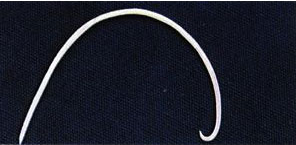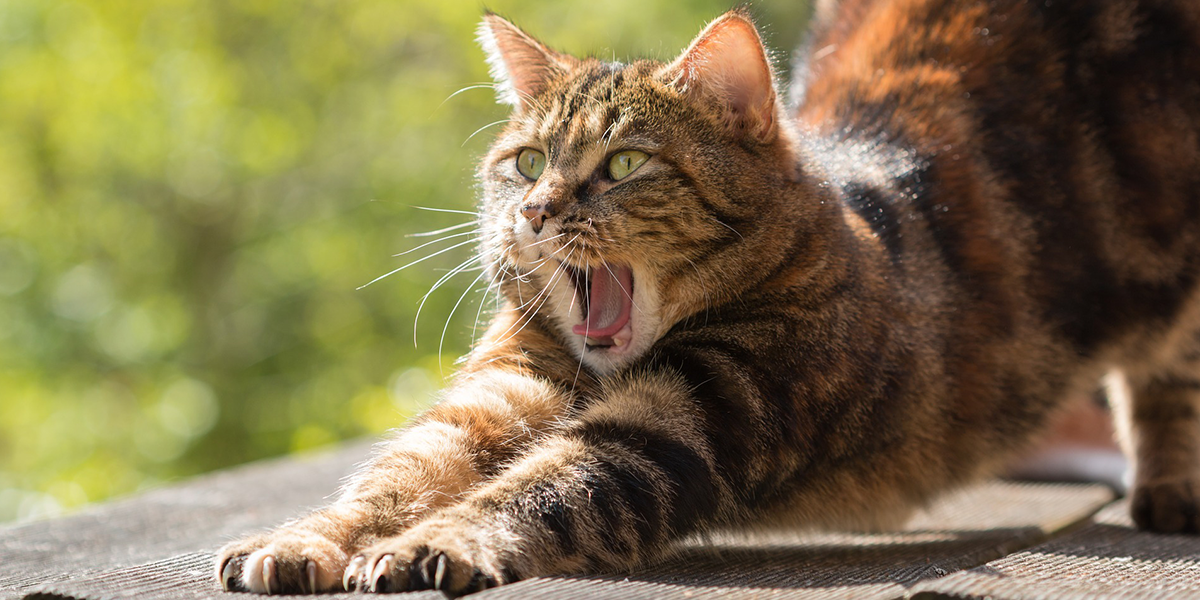How Soon Can I Worm My Cat Again
The almost common intestinal worms cats go are called roundworms and tapeworms. Most infected cats practice not prove signs of having worms; nonetheless, heavy burdens of worms tin cause weight loss, vomiting and diarrhoea, irritation around the anus and failure to thrive.
Importantly, while worms can sometimes crusade problems for the cat itself, some worms can also be passed on to humans and on rare occasions can be a cause of serious human disease. For these reasons, regular treatment of cats and kittens to prevent or eliminate worms is very important.
Types of worms
Roundworms

Intestinal roundworms are the almost mutual abdominal parasites in cats and occur in cats of all ages throughout the globe. The two common roundworms of cats are called, Toxocara cati and Toxascaris leonina. Eggs from these worms are passed in the faeces and can remain viable in the surroundings for several years. These eggs can infect other cats in ii ways. Start, a cat may eat (ingest) eggs directly from a contaminated environment. 2nd, if some other brute eats the eggs (eg, a mouse or rat), these can act as 'intermediate hosts' and pass on the infection to a true cat if it preys on (and eats) the infected intermediate host.
Toxocara cati is also passed from queens (mother cats) to kittens through the milk she produces. Whenever a cat is infected with roundworms, some young forms (larvae) remain dormant in tissues in the body. This usually causes no damage, but when a female cat becomes pregnant, these larvae migrate to the mammary glands and are excreted in the milk she produces for the kittens. This is a very common route of infection and nosotros should assume that every kitten will be infected with Toxocara cati as a upshot.
In most cases, regular routine handling for roundworms is recommended throughout a cat'due south life. However, to make up one's mind if a cat is actually infected with worms, a faeces sample can be nerveless and examined in the laboratory to look for the presence of the worm eggs.
Other gastro-intestinal roundworms that may infect cats in various parts of the earth include:
- Ollulanus tricuspis (found in the stomach)
- Gnathostoma spp
- Physaloptera spp
- Strongyloides spp
Hookworms
Hookworms are a type of small abdominal roundworm found in nearly countries throughout the world, but are more common in some countries than others. These worms tin crusade damage to the lining of the intestine where they attach to the surface, and this may result in weight loss, bleeding and anaemia.
Cats may exist infected by ingestion (eating) eggs from the environment, from eating an infected intermediate host (as with Toxocara cati to a higher place) or past the larvae in the environs burrowing through the cat's skin.
Common cat hookworms include Ancylostoma tubaeforme, and Uncinaria stenocephala, only other species occur in some countries.
Tapeworms

Tapeworms are generally long flat worms composed of many segments. Mature segments containing eggs are released from the end of the tapeworm and are passed in the faeces. These segments often resemble grains of rice and can sometimes exist seen on the pilus around the anus of the cat, in the faeces and on the cat'southward bed.
To complete their life-bicycle, all tapeworms crave an intermediate host to first swallow the eggs from the surround, and then the cat will become infected past eating the intermediate host. Animals that human activity as intermediate hosts vary depending on the species of tapeworm. The most mutual tapeworms that infect cats worldwide are Dipylidium caninum and Taenia taeniaeformis.
Dipylidium caninum is transmitted to cats by fleas. The immature fleas larvae ingest the eggs of the worm, but infection is then passed on to a true cat when it swallows an infected flea during grooming. It should exist causeless that any cat infected with fleas too has Dipylidium caninum (and vice versa).
Taenia taeniaeformis is passed on when they swallow small rodents (rats and mice), the rodents having eaten eggs from the surroundings. This infection occurs very commonly in cats that hunt.
Other tapeworms that occur in some countries include:
- Diphylobothrium latum (fish are intermediate hosts)
- Spirometra spp (amphibian, reptiles and rodents are intermediate hosts)
- Diplopylidium spp (reptiles are intermediate hosts)
- Joyeuxiella spp (reptiles are intermediate hosts)
- Echinococcus multilocularis (rodents are intermediate hosts)
Worming your cat
Roundworms are extremely common in kittens, and as kittens tin can be infected from the mother's milk it should be assumed that all kittens are infected and worming should be started at a young age. Common recommendations are to:
- Treat kittens for roundworms every 2 weeks from three weeks of age until 8 weeks of historic period, and then monthly to 6 months of historic period
- Care for developed cats (greater than 6 months of age) every i-three months
Tapeworms are only usually a problem in older cats, unless a kitten as well has fleas.
- Treat adult cats (greater than 6 months of age) every 1-iii months with a product that is effective against both tapeworms and roundworms.
A production active against Dipylidium caninum should likewise exist used in kittens that accept flea infestations.
Which worming products to use?
At that place are many unlike worming products available on the market, and drug availability varies betwixt different countries. While worming products may be available from pet shops and even some supermarkets, these are often sometime or less effective products and some are even less safe to use in cats.
It is always better to seek the communication of your vet, who will know what types of worms occur usually where y'all alive, and will be able to recommend the most constructive and safest treatments for your cat. Additionally, some treatments are available which may exist easier to administer, such as an injection that your vet tin can give, a tiny tablet that tin can become in with food, or even some drops that can be practical to the pare.
See as well our information on how to requite your cat a tablet.
Other worms
In addition to intestinal worms, cats tin be infected with a variety of other worms in other sites of the trunk, although often these worms are not present in all regions of the globe. These include:
- Dirofilaria immitis – heartworm
- Aelurostrongylus abstrusus – lungworm
- Capillaria spp – lungworm
- Thelazia callipaeda – eyeworm
Thanks for visiting our website, we hope yous have found our information useful.
All our advice is freely attainable to everyone, wherever you are in the world. However, as a clemency, we demand your support to enable us to go along delivering high quality and up to date information for everyone. Delight consider making a contribution, big or small, to keep our content free, accurate and relevant.
Support International True cat Care from as trivial £3
Thank y'all.
Donate At present
Source: https://icatcare.org/advice/worming-your-cat/